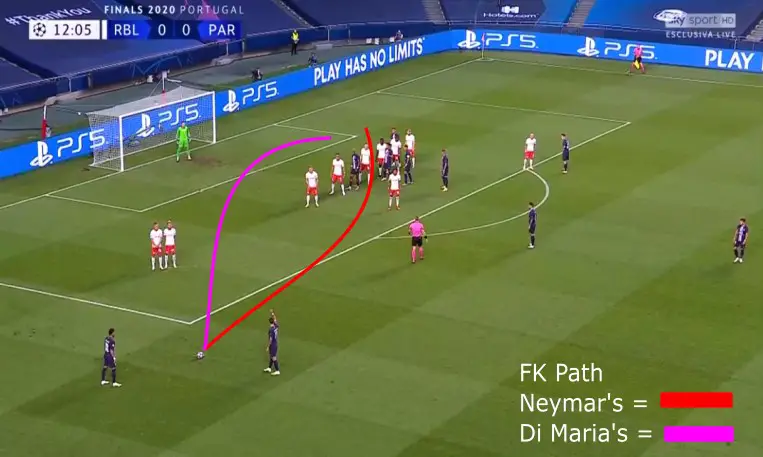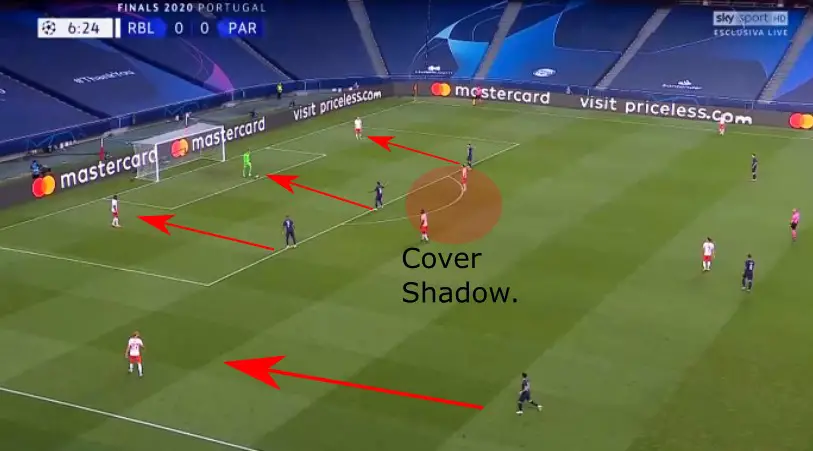COVID-19 has brought a chain of strange events to football. Champions League has turned into 1-leg knockouts, all to be played in Southern Portugal, behind closed doors. Along with that, we’ve seen the majority of the usual suspects of the tournament such as; Juventus, Barcelona, Real Madrid, Atletico Madrid and Liverpool all knocked out. Does the current situation have a hand in this? Who knows. PSG scrapped through their quarter-final vs. Atalanta with 2 late goals the last behind from super-sub Chuopo-Moting. Leipzig had a fairly convincing game vs. Atletico Madrid where Madrid team struggling to deal with Leipzig’s fluid in/out of possession movements.
With Leipzig’s first-ever Champions League semi-final and only Paris Saint Germain’s second, this would be an interesting battle as old acquittances reunite in Thomas Tuchel and Julian Naglesmann. Thomas Tuchel stated post-conference that he was “5 minute from losing his job” showing just how crucial European success is for PSG, whereas Leipzig are a club that have recently risen up in Germany and were looking happy to compete as outsiders in the competition. The contrast in pressure is astonishing. With PSG known for strong positional play, influencing games through high possession and a deadly trio up front. Whereas Leipzig’s positional fluidity and young stars intrigued me into writing this. This article will cover the tactical outline of how PSG triumphed Leipzig and how the differences in quality really made the cutting edge in this tie.
Tactical Overview

Leipzig under Nagelsmann has seen all sorts of formations from 3-1-4-2 to the ‘reverse T’ (4-2-2-2 narrow). They opted for a 4-1-4-1 out of possession which quickly changed to a 3-3-3-1, similar to what we saw against Atletico. The key feature of this being Angelino controlling the left flank as a single #3, meaning he could not only track back effectively and defend counters but stay wide and deliver crosses into the box. This meant Klostermann would cover the right half-space, Upamecano would come central and Mukiele would drift in as a RCB creating a 3 to deal with PSG’s front 3. Upamecano playing at RCB (left-footed) and Klostermann LCB (right-footed) allowed the centre-backs to track inverted wingers runs and time tackles. E.g. Neymar and Mbappe could drift infield onto their right foot and it’d be easier for Upamecano to stop. Furthermore with Angelino’s shift to LW this allowed Nkunku to drift infield whilst Leipzig were in a position to create (averages 2.4 key passes per Bundesliga game!). Kampl played an unusual #6 role which didn’t require him to break up play as such but more to read gaps and intercept with MF 4 in front him, mostly when Neymar drifts infield. On the counter/attacking spells, it meant Leipzig could go forward with 3 attack-minded midfielders. Kampl on the ball helped progress play where he could in a PSG midfield which pressed aggressively. 75% of his forward passes were accurate within the game. Olmo and Sabitzer acted as 10s and drifted inside to create fast counter attacks and progress the ball once possession was regained. Creative players by nature they relied on there shape off-the ball and compactness to win the ball, once it was won they were given more freedom to attack at a higher tempo.
Once PSG went 1-0 up the off-the ball shape changed slightly with Olmo dropping into a #10 position to create and 4-4-1-1/4-4-2 and gave Poulsen a pressing partner. For the 2nd half RB Leipzig turned into a 3-5-2 which we’ll speak about later.

PSG also like to switch around formations and opted with a 4-3-3. Marquinhos operated as a #4 but this dynamic was dependant. At times he was used as a False #6 and reverted into a back 3 during high pressure or would drift between Olmo and Sabitzer as an outlet. Herrera operated higher towards the right interior drifting between the lines but his main role was to press off the ball and aid Kehrer on the right flank. Neymar was a deep lying forward who looked to receive between the lines and do what he does best, dribbling and creating chances through the middle of the pitch. Mbappe and Di Maria would hold the width towards the opposition wing-backs however would drop in the middle and create 1-2s/passing combinations with Neymar once an attack was on. If a CB went with Neymar this would leave gaps in behind for Di Maria and Mbappe to exploit, similar to Barcelona in 2011. The front 3 also pressed aggressively including the goalkeeper to result in long-ball giveaways, allowing PSG to recycle possession and begin build-up. Parades a traditional #8 looked to break lines but hardly moved from the RCM area, holding his position and winning the ball aggressively when needed.
Open-play first-half

After a few minutes, PSG began getting into their rhythm and setting their shape whilst Leipzig dropped into the 4-1-4-1. PSG had a clear numerical advantage at the back, with their ‘box’ system allowing the full-backs to get high and wide to create width and Di Maria/Mbappe giving height. Through this box, Olmo and Sabitzer would help Poulsen press the ball if a trigger allowed them to do so. Whilst pressing they had to ensure Neymar or Herrera were unavailable options through their cover shadow. This got PSG playing at a higher tempo but hardly anything was won from these situations, which can be seen in the graph below for Leipzig’s ground duels won. The majority Leipzig’s possession recovery came from their left side where Herrera and Kehrer were disposed, less technically gifted players within the PSG team. With this in mind, PSG’s ‘strong side’ in build-up was through Bernat, a player who has shone since the lockdown. With the problems he could potentially cause, Nagelsmann operated Laimer (tireless hard worker) at RM to nullify his ability.
Even though Leipzig struggled to recover the ball they got the mid-block positioning down to a tee. Hardly any threat came from long balls, something Mbappe and Di Maria could exploit with just a half chance. Furthermore in build-up, PSG were stuck at times as they wished to progress through the middle they found it difficult to find Neymar between the lines and Herrera, who may have drifted higher like more of a decoy player. Starting off as an asymmetrical square, Paredes quickly recognised the space within the left-interior giving him time to pick a pass and have an open body shape to pass through the middle. Once this occurred Marquinhos drifted slightly higher in the oppositions half and began creating 1-2s and small combinations to feed the ball into Neymar, where he can be incredibly dangerous. In the beginning, Leipzig’s open-play off the ball was brilliant but their persistence play out and PSG’s sporadic set-pieces cost them 2 goals.
High-press and Set-pieces
Whilst PSG struggled to play through the mid-block what they did do was make the most of set-pieces. The 1st goal, for example, started as a throw-in, which Bernat tactically won, then carried on to win a corner via a deflection. 1st corner was taken by Di Maria as an out-swinger towards Marquinhos – Leipzig see it out, another corner won. 2nd corner Di Maria plays it short to Neymar, Neymar then plays it back to Di Maria who enters the box to place a low cross – Leipzig clear, another corner! 3rd corner Neymar takes but plays it short to Di Maria, Di Maria passes towards the edge of the area where Neymar is… wins a foul. The free kick has a cross written on it Neymar places the ball down, Leipzig defence adjust, Di Maria hits an out swinging cross – goal, Marquinhos. Within 2 minutes PSG had won a throw-in within the final 3rd, 3 corners and a free kick and scored from dead-ball situations, its margins like this that wins games at this level. As both Di Maria and Neymar have deadly set-piece delivery it encourages a ball to be whipped in, however the space left to either side gives them space to dribble and combine, on top of that the goalkeeper and defence find it difficult to read where the cross will come from (in-swinging or out-swinging). This is clearly something Tuchel has worked with and gained a great advantage in doing so. As you can see from the diagram the goalkeeper was expecting Neymar to hit the free-kick, therefore, sat deeper to catch and claim. Di Maria’s out-swinger travelled towards the near post giving Marquinhos the space to head home.

Similarly to the 1st goal, the 2nd goal started from a throw-in. This time Leipzig’s throw. As the throw allowed them to play from the back, Gulacsi miss-hit a pass into the middle and PSG quickly capitalised to make it 2-0, however, the warning signs were there early. Gulasci was constantly closed down this game, which shows as the goalkeeper had a 68% passing accuracy the lowest it has been in his last 7 games! From the diagram you can see PSG’s front 3 pressed very aggressively, Gulacsi didn’t have the composure and look to clear his lines when he can. A goal actually resulted in that situation but was called for a foul the warning signs were there! Gulasci can play out through the back well but when rushed down always seems to clear his lines, another tactic PSG exploited. Upamecano a very comfortable promising ball-playing defender, played brilliant through balls towards the beginning of the game but then it was obvious PSG began to target him. His passing accuracy was 84% the lowest out of all the centre-backs playing that day.

Overall Leipzig’s set-up off the ball was good but the counter attacks lacked a punch. With crosses closed down and Silva, Marquinhos and Kimpembe working tirelessly they kept Leipzig at bay with only 3 shots on target the whole game towards Rico’s goal, all from outside the box. Whereas PSG managed 5 shots in the box, 3 being goals. Taking aside the tactical set-ups, Leipzig were clearly nervous going into this game and cause their own problems within this game. They didn’t have a player that could step up to such a game, maybe if Timo Werner was still at the club the game could’ve panned out slightly differently. PSG showed in this game possession does win you football games, even if you don’t need to penetrate consistently, counter-pressing and being switched on the transitions really made the differences this evening.








